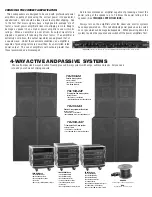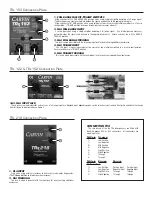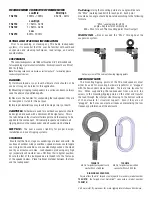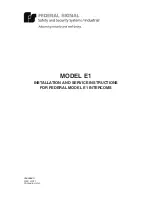
TCSHK10
3/8-16 forged steel eyebolt with
washer WLL=1600 lbs.
TCSHK15
3/8-16 forged steel quicklink
connector WLL=2000 lbs.
RIGGING ACCESSORIES
Carvin offers the 3/8” forged steel eyebolts & washers (model number
TCSHK10
), the forged steel Quicklink™ connectors (model number
TCSHK15
).
Visit www.atm-fly-ware.com for more rigging information and hardware.
IMPORTANT NOTE
The mounting/rigging points of the TRx loudspeakers must
either be used for mounting hardware (eyebolts) or “plugged”
with the hex-socket screws provided. There are two reasons for
this. When suspending the loudspeaker from one end, the
screws in the mounting/rigging points on the other end transfer
the load through the internal steel bracing to the bottom surface
of th enclosure for structural support. Also if they are not
“plugged”, the holes can create air leaks compromising the low
frequency performance of the enclosure.
Cutaway view of TRx cabinet showing rigging points.
RECOMENDED CROSSOVER FREQUENCIES
Low/Mid
Mid/High
TRx153
400Hz - 700Hz
2.5kHz - 4kHz
Low/High
TRx152
1.75kHz - 3kHz
TRx122
1.75kHz - 3kHz
Low
TRx218
80Hz - 100Hz
De-Rating:
Using the mounting points at an angle will de-rate
the “WLL” (working load limit) for each point. Each point
mounted at an angle should be de-rated according to the following
formula.
“WLL”=cosine(angle) x 500
angle = degrees form vertical pull
500 = WLL for each TRx mounting point @ vertical pull
WARNING –
Never exceed the “WLL” throughout the
suspension system
.
FLYING AND STACKING INFORMATION
Prior to suspending or stacking any TRx Audio loudspeaker
systems, it is essential that the user be familiar with overhead
suspension and stacking techniques, load ratings, and safety
considerations.
SUSPENSION
TRx series loudspeakers are fitted with captive 3/8”-16 threaded nuts
for suspending or permanent installation. Each captive nut has a WLL of
500 lbs. (226 kg.).
Note
: Working Load limits are based on vertical pull or 0°, for derating please
see derating note below.
DANGER:
1)
Hardware found at your local hardware store should not be
used as it may not be rated for this application.
2)
Mounting or rigging loudspeakers is a serious endeavor, always
seek the advice of qualified experts.
3)
Never use the handles for suspending the loudspeaker, they are
not designed or rated for this purpose.
4)
Improper installations may result in damage, injury or death.
CAUTION:
All hardware used for overhead suspension should
be designed and used with a minimum 5:1 design factor. This is
the ratio between the structural failure point and the loading to be
applied to the component. Periodically inspect and maintain all
rigging points on the loudspeaker and all suspension hardware.
NOTICE:
The user assumes liability for proper design,
installation and use of rigging systems.
STACKING
Ensure that the floor, stage or soundwings are level and solid. Be
cautious of outdoor windy conditions, speaker stacks could topple
over in high wind conditions or be accidentally pushed or bumped
over by over zealous crowds. Loudspeakers producing very high
spl (especially subwoofers) can shift from their original position.
Ensure the feet of the loudspeakers are locked into the feet cups
of the speaker below. Place frictional material between the floor
and the loudspeaker.






















